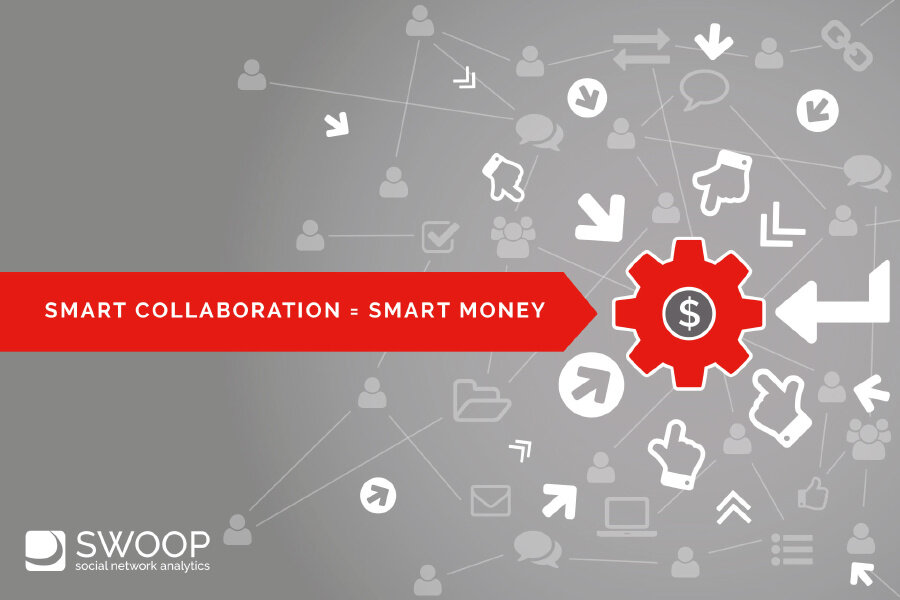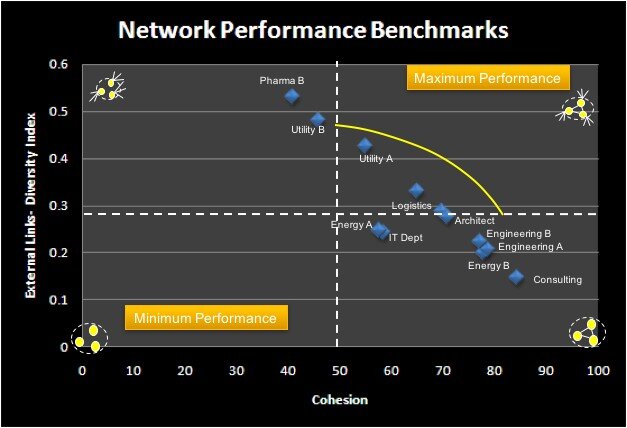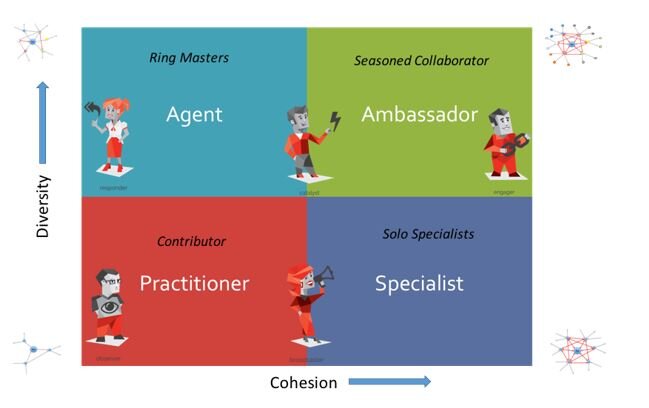Smart Collaboration = Smart Money
‘Smart Collaboration’ is the title of Harvard’s Heidi Gardner’s latest book. The book builds and expands on her well cited HBR article “When Senior Managers Won’t Collaborate”, where she presents some compelling data demonstrating that collaboration does pay, big time. Her network representation comparing the networks of two lawyers, with Lawyer 2 responsible for generating much higher revenues from her larger and more diverse network, may seem quite logical. Additionally, she shows that greater peer-to-peer collaboration does indeed generate much higher revenue levels; the key measure of success for most advisory firms. But those whom have worked in Partner led advisory firms, will understand the tribal norm of ‘Eat what you Kill’, can actively work against cross-enterprise collaboration. Gardner’s research will hopefully go a long way toward convincing the leaders of advisory organisations that it is time to abandon this tradition. But in the book she acknowledges and addresses head on, the challenges ahead.
In a decade of conducting survey based Organisational Network Analyses (ONA) projects around the world and across many industry sectors, we have found that it is the partner led organisations that fall most strongly into the ‘tribal’ area (High cohesion/Low Diversity) of our Network Performance framework.
The above graph plots a representative set of results from client projects undertaken over a decade. In our surveys we use a common question of “Who do you rely on to get your work done?”; to identify people to people relationships. We then look at the proportion of reciprocated (two-way) relationships to devise a cohesion score. The y-axis diversity score is determined by the proportion of cross-departmental activity, similar to Gardner’s ‘cross practice’ measures for consulting organisations. The bottom right region (High Cohesion/Low Diversity) is populated by advisory firms i.e. consulting/engineering etc.. Our advice to these firms mimics that of Gardner’s, to grow the diversity of their work teams, without sacrificing the existing levels of cohesion. This is easier to say than do, as you can see from the above data; diversity and cohesion are often traded off against each other, yet this doesn’t have to be the case.
So How can Partner-Led firms be Disrupted by Smart Collaboration?
In her book, Gardner uses role archetypes to characterise the different behavioural dimensions typically found in partner led organisations. Interestingly, we find a strong correspondence to our own ONA characterizations, and more recently our on-line collaboration personas.
Gardner also identifies the increasing use of collaborative software platforms by professional services firms to help ‘break down the silos’, to better facilitate ‘smart collaboration’. While we agree with the principle, the devil can be in the detail. Without a supporting collaborative culture, these platforms can be used to actually reinforce existing silos. We have seen many instances of teams creating private groups on the pretense of ‘competitive sensitivities’; sometimes warranted, but more often not.
The following chart identifies the synergies between Gardner’s archetypes overlaid onto our Personal Networking Performance framework, to provide a link to our network centric perspective. Additionally, we also overlay our online networking personas to extend the view further to the online collaboration environment within which SWOOP’s analytics operate.
As we can see, there is a direct mapping between Gardner’s archetypes and our Networking archetypes. The ‘Seasoned Collaborator’ is Gardner’s key role supporting ‘Smart Collaboration’. Likewise, our ‘Ambassador’ role plays the key brokering role in networks, bridging the diversity/cohesion divide. The ‘Solo Specialists’, like our ‘Specialists’ have strong, cohesive, yet localised networks. The ‘Ring Master’, like our ‘Agent’ are playing an oversight role. They have diverse networks, but not the power to necessarily drive positive actions to the same degree as the ‘Seasoned Collaborators/Ambassadors’. Finally, the ‘Contributor’ / ‘Practitioner’ have both limited diversity and cohesion in their networks. They are more regularly younger or new to the organisation staff; or staff that are comfortable to ‘do their bit’, without trying to ‘push the envelope’.
By extending this framework to the online world, we are escalating the analytics from ‘snapshot’ project based analyses, to the real-time online analytics that SWOOP provides. Online analytics can measure and monitor ‘Smart Collaboration’ in process. We have now benchmarked close to 50 organisations on a series of collaboration indices, which include the behavioural personas indicated. The correspondence is not one-to-one, but nevertheless still informative.
The ‘Engager’ maps closely to the ‘Seasoned Collaborator / Ambassador’ archetype, by identifying those participants whose online networks are both diverse and cohesive. The important ‘Catalyst’ persona instigates interactions. They are key to growing online communities, but are not always those that broker connections. Hence they are located between the ‘Agents/Ringmaster’ and ‘Ambassadors/Seasoned Collaborator’. The ‘Responder’ persona will regularly have a diverse, yet less cohesive online network. There is not a correspondence with the pro-active ‘Agent/Ringmaster’ role, as the role is more re-active, than pro-active. The ‘Broadcaster’ tends to prioritise ‘telling’ over ‘discussing’. In this sense the behaviour is similar to the solo specialist, but ‘Broadcasters’ do not have highly cohesive networks; hence their positioning toward the ‘Contributor’/’Practitioner’. Finally, the ‘Observer’ persona has minimal participation in the online platform and therefore has low or non-existing online diversity and cohesion. The ‘Observer’ is an artefact of online platforms and there is little, if any, correspondence to the ‘Contributor / Practitioner’ archetype.
So can digital ‘Smart Collaboration’ disrupt the current status quo of the big end consulting companies? Well Harvard Professor Clayton Christensen thinks so. He wrote an article on ‘Consulting on the cusp of Disruption’ back in 2013, citing the clients’ drive for more transparency and also the increased availability of big data analytics and predictive analytics. More recently, this article on ‘Big Four Firms face tsunami of threats from Digital Groups’ also explores the digital disruption potential. And of course Heidi Gardner’s ‘Smart Collaboration’ might be framed as a helpful guide to partner led advisory firms, but could also be read as a ‘if you don’t, someone else will’ warning to the incumbents.
Final Comments
In this article we aimed to draw linkages between Heidi Gardner’s recent work on ‘Smart Collaboration’ and firstly, our own organisational network analysis consulting work. We both used survey techniques to elicit our insights, though Gardner also drew from personal interviews and observations. The extension of these insights toward insights that can be drawn from online interactions is still ‘work in progress’. Unlike surveys, interviews and observation; online analytics has to create its insights through more indirect means. That said, the wealth and volume of data available online swamps the data that can be gained from traditional surveys and interviews. At SWOOP we have now collected and analysed collaboration data from more organisations in less than two years, than from a decade of consulting projects. While consulting projects are often necessarily constrained to a limited scope, the online analysis, drawing its data from the collaborative online platforms, covers the full breadth of these organisations.
We are excited by the potential for online analytics to facilitate ‘Smart Collaboration’ in real-time. Watch this space for updates on our collaboration benchmarking research.




